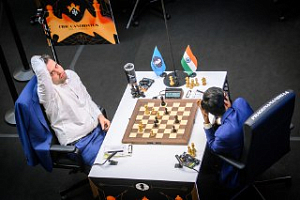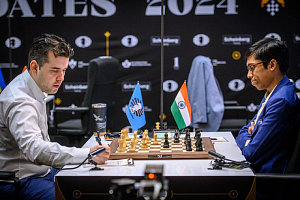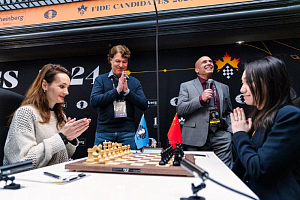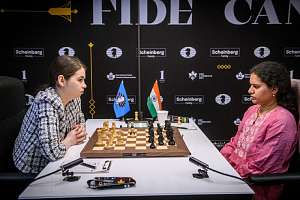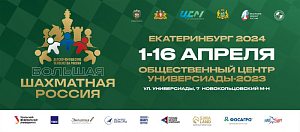A Reliability Strategy from Caruana
Vladimir Barsky reports from Berlin about round seven of the Candidates Tournament
With the second rest day over, the Candidates Tournament in Berlin is back on track. As it was Sunday, Kühlhaus was filled to capacity with spectators, who would disturb silence in the playhall from time to time. However, as Levon Aronian joked at the press conference, whey you play badly, then your play is affected by everything, but when you play well it’s not! Levon answered questions with calm dignity, without showing any emotions, although the round seven defeat has practically deprived him of any chances for a matchup against Carlsen. "This is one of the worst tournaments in my career; if not the worst,” added Aronian.
In the round seven the Armenian grandmaster was White against the joint leader Fabiano Caruana. Getting back into contesting the first required Aronian's outplaying a dangerous competitor. He had a fantastic novelty prepared for this principled battle: a move looking very aggressive and somewhat ridiculous at the same time.
"Did Aronian really played 16.g4? That has to be a mouseslip. I would not have predicted that if you would have given my 10 guesses!” – twitted the English grandmaster Nigel Short. Indeed, it was surprising that in a well-known theoretical position, Whites offers a sacrifice of two pawns and exposes his king by sending all sheltering pawns to storm the enemy's bastions.
"At first I did not believe that White would have sufficient compensation for the material because of my pair of bishops," admitted Caruana. – But when I dived into the position I realized that there was no direct refutation of White’s idea. This said, I was not feeling any special psychological pressure as I had had worse positions to defend!
There is no doubt that Aronian prepared a daring idea at home, but the impression was such that he had not had enough time to analyze it in great detail. He might have invented this bayonet attack during the Candidates tournament itself after having suffered a defeat in round three from Vladimir Kramnik, who had uncorked a similar maneuver g7-g5. Whatever the reason, not only did Levon have any time preponderance, but used up even more time than his opponent, whom he caught unawares. Caruana chose a "strategy of reliability": his moves were probably not the strongest, but very robust, and Black was nowhere near losing the game at that. In the meanwhile Aronian had to strain his imagination to maintain tension and create threats on the kingside. Levon got into a severe time trouble, several times making moves with only seconds on his clock: one time with three, another time with nine...
However, Caruana is not made of steel: once in time trouble, he allowed the opponent to deliver an effective blow, upon which a fantastic position could have arisen on the board with White having only a pawn for the rook, but his infantry being so strong as to compensate for a huge material disadvantage. Turning fiction into reality required Aronian making only one precise move, but he lacked time to make it happen. He delivered two impulsive checks, after which White's position became hopeless; on move 37 he recognized his defeat.
Aronian – Caruana
1. d4 Nf6 2. c4 e6 3. Nf3 d5 4. Nc3 dxc4 5. e4 Bb4 6. Bg5 h6 7. Bxf6 Qxf6 8. Bxc4 c5 9. 0-0 cxd4 10. e5 Qd8 11. Ne4 0-0 12. Qe2 Be7 13. Rad1 Qc7 14. Bd3 Nd7 15. Rc1 Qa5

16. g4!? Nxe5 17. Nxe5 Qxe5 18. f4 Qa5
In post mortem Caruana proposed 18…Qd5, but Aronian turned it down on simple grounds of not working out for Black. However, the latent subtlety is not obvious because in response to 19.g5 Black could have retreated his bishop to d8 to arrive at the same position.
19. g5 Qd8 20. h4 Bd7 21. gxh6 g6

22. h5
Aronian condemned this move, saying that 22.Ng6 is stronger from a practical point of view, posing hard problems for Black to solve. The engine, on the other hand, votes for this move. Those of you who are willing to delve into the subtitles of this position are welcome to familiarize with Alexey Korotylev's analysis on ChessPro.
22... Kh8 23. Kh2
This and the next move put White on the verge of defeat.
23… Bc6 24. Rf3 Bd6
Caruana refuses from 24... Qd5 in view of 25. Rg3 Qxh5+ 26. Qxh5 gxh5 27. Rg7 – and grandmasters voiced this position as dangerous for Black. However, the engine continues the line to easily thwart all White’s threats: 27…f5! 28. Ng5 Bxg5 29. fxg5 Rg8 30. Rxg8+ Rxg8 31. Rg1 Kh7, with a decisive edge.
25. Qf2 Bc7 26. Kh3 Qe7 27. Ng5 e5
The tension in the position has reached its peak. Despite severe time trouble, Aronian comes up with a brilliant sequence.

28. Rxc6! bxc6 29. Nxf7+! Rxf7 30. hxg6 Rf6 31. g7+
It is stronger than the immediate 31. Qh4, because after 31… e4! 32. Bxe4 Qe6+ 33. f5 Qd6 34. Kg2 Qe7 Black has definite winning chances.
31... Kg8

32. Bc4+?
This is quite unnecessary. White was saved by 32. Qh4! e4 (or 32... exf4 33. Bc4+ Kh7 34. Bd3+) 33. h7+ Kxg7 34. Rg3+ Kh8 35. Rg8+ Rxg8 36. hxg8Q+ Kxg8 37. Bc4+ Kg7 38. Qg5+ Kh7 39. Qg8+ Kh6 40. Qg5+, with a perpetual.
32... Kh7 33. Qh4 e4! 34. Rg3 Bxf4!
Fabiano keeps his head cool and manages to come up with the strongest moves. “Caruana is a genius,” Laurence Trent would exclaim from time to time while commenting online with Judit Polgar. Judit, a brilliant tactician herself, praised Levon’s ingenuity.
35. g8Q+ Rxg8 36. Bxg8+ Kh8 37. Rg7 Qf8!
It was not yet too late to go wrong: 37... Qd6? 38. Rh7+! Kxg8 39. Qg4+ Rg6 40. Rg7+ Kf8 41. Qc8+, with a checkmate next move. After the text the g7-square has been taken care of, which compelled White to recognize his defeat.
The opposite of this chess action was the game of another leader, Shakhriyar Mamedyarov. He also had black color against Alexander Grischuk. The Russian grandmaster is known for his combative and principled play, the recent rounds having demonstrated his being in a good form and performing on a very high level. However, Alexander obviously missed something during his preparation and was unwilling to go into further details, saying only that he was very disappointed with this game because the opponent made a draw as Black without even having to spend any time thinking on his own. Well, it happens sometimes, and Grischuk acted quite logically: realizing that his opponent outwitted him, he would not persist further and bailed out safely.
The first tournament victory that day was scored by the 2016 world vice-champion Sergey Karjakin, who explained it in detail to your correspondent:
– I spent a day off resting and preparing, and this morning I went to the polls. I would like to thank the Russian Embassy in Berlin: they sent a car to pick us up - once we arrived at the Embassy it took only 15 minutes to vote and go back, including communication with the mass media.
I did not know much about 7…cxd4; they normally play 7…Bxc3 in this position. I got the advantage of a bishop pair out of the opening and, in my opinion, played it logically, but Wesley So found a strong idea 11... Bd7 and 12 ... Rc8, which exposed the weakness of my b4-pawn. I guess I did something wrong, although, honestly speaking, I did not see where I could do better than that. Black managed to equalize, and after 23... Nxb2, truth be told, you could already agree to a draw, but I kept looking for some opportunities to turn up. Wesley was let down by his passive play as he was willing to make a comfortable draw, while it was necessary to pull together and find several precise moves.
Karjakin – So

“This is an important moment: I see no big problems for Black after 26…Rb6. 26…Re8 lets go of a draw not yet, but it is an overly passive strategy. It was not a good idea, taking into account that it gives me a free hand to bring my king into play.
27. e4 Nc4 28. Kd3 Nd6
He was obviously averse to playing 28…Ne5 to defend a rook ending down a pawn, but, objectively speaking, it is a draw.
29. f4 Kf8 30. e5 fxe5 31. fxe5 Nf5
I think he misplaced his knight; he should have placed it on f7, intending to drive its counterpart from c6. For example, 32.Kc4 Nd8 33.Nd4 Nf7, with a simple draw. As opposed to this, after 31…Nf5 32.g4 I no longer saw any comfortable draw for him. Perhaps, he should have rerouted his knight via Nh6-f7 to carry out the idea I have just mentioned.
32…Nh4 33. Kc4
Now my king infiltrates the queenside. Let me mention a strong idea 34.Ra2, intending 35.Rf2. He again needed to plant his knight on f7 via g5, even though Black’s position must be difficult already because I can bring my king to d7 just in time. Honestly speaking, 35…Ke8 is a crazy move because it is resignable after 36.Kb6, putting Black into zugzwang (S. Karjakin’s comments at the press conference).
33…Nf3 34. Ra2 Rc8 35. Kb5

35…Ke8?
A resourceful engine points out that the position is still tenable after 35...Rc7! 36. Kb6 Rd7!, and 37.Rf2 is met by 37…Rf7, whereas 37.Ra8+ is answered by Kf7.
36. Kb6 g5 37. h3 Nxe5 38. Nxe5 Rc3

39. Rh2
“I wanted to play 39.Ra7, but could not calculate till the end the line 39. Ra7 Rxh3 40. Kc6 h5 41. Kd6 Kf8. Being a very committal decision, I opted for a safe 39.Rh2, and the opponent suddenly ran out of time a move later. Even though White’s position is hopeless, it still takes a certain amount of technical play to convert. I am happy about my first victory” (S.Karjakin).
Sergey’s intuition did not let him down: After 39.Ra7! 39. Ra7 Rxh3 40. Kc6 h5 41. Kd6 Kf8 White wins indeed, but the followup complications are mind-boggling: 42. Kxe6 hxg4 43. Ng6+ Kg8 44. Ne7+ Kg7 45. Nf5+ Kh8 (or 45... Kg6 46. Rg7+ Kh5 47. Kf6 g3 48. Rxg5#) 46. Kf6 Rb3 47. Ne7 Rb6+ 48. Kxg5 g3 49. Ng6+ Kg8 50. Kh6. Thus, Sergey’s decision was absolutely justified from the practical point of view.
39... Ke7 40. Kb5 Re3 Black resigns.
And the longest - which no longer surprises anyone - was the game played by Vladimir Kramnik. The former world champion tried to break down Ding Liren’s resistance for almost seven hours, but ended up nowhere. “Being the most senior participant here, I should have, perhaps, made a few short draws so as not to tire myself out, - reasoned Vladimir after the game. – But I like to play the way I play: with full tension, trying to find out the slightest chance of winning, and I'm not going to give up on my style."
Kramnik tried to foist a viscous play as White in the English opening on his opponent, holding the opponent's pieces at the distance, but committed an inaccuracy and allowed Black to deal a powerful central blow, which handed the initiative over to Black. Ding Liren had a pleasant choice of winning the exchange for a pawn or taking the queen for a rook, knight and pawn. He chose for the second option, but did not find the way to achieve a real advantage, and allowed Kramnik to benefit from simplifications. The scales began to weigh in White’s favor, but shortly before the time control the Russian grandmaster returned an error by allowing the opponent to grab an important pawn on b3. It soon became clear that there were no more real chances for White to win the game. Nonetheless, Kramnik persisted and managed to come up with a very cute trap, which Ding missed in his advanced calculations. Objectively speaking, however, Black‘s position was not inferior and he had a decent rejoinder, which convinced White to force a draw.
Kramnik – Ding Liren

Any player would be content with a draw here, but this is, fortunately, not about Kramnik.
56. g4!? hxg4 57. h5+ Kf7 58. Rd7+ Ke6 59. Rg7 Qe2 60. h6 Qf3+ 61. Kg1 g3 62. Rxg3 Qh5 63. Rg7!

White sets a cute-looking trap, the crux of the whole idea behind his preceding play. Ding Liren cupped his head in his hands: in his advanced calculations he failed to spot that after 63... Qxh6 64. Re7+! Kxe7 65. Nf5+ Black ends up down a piece! Nevertheless, the position is still a draw after (65…Ke6 66. Nxh6 f5 67. Kf1 f4, etc.), but there is little doubt that such upheavals are not something that Black is interested in.
63…f5 64. h7 f4 65. Ng4 Qh3 66. Rg6+ Kf5 67. Rg7 Ke6 68. Rg6+ Kf5

It is surely a draw by repetition now, isn't’ it? Not quite, as Kramnik is not yet prepared to say farewell to this interesting game!
69. Nh6+ Kxg6 70. h8Q Qxh6 71. Qe8+ Kf5 72. Qb5+ Kg4 73. Qe2+ Kf5 74. Qb5+, and it was only after this move that the opponents signed a peace treaty.
Even at a press conference Kramnik would not give up attempts to defeat his opponent, claiming an overwhelming advantage in all possible continuations... A fantastic charge on fighting! Ding Liren only gave modest smiles and shakes of his head, from time to time suggesting moves which allowed Black to keep everything under control...
Standings after round 7 (after the end of the event’s first half )
1. F. Caruana - 5 out of 7; 2. S. Mamedyarov – 4.5; 3-5. A. Grischuk, Ding Liren, V. Kramnik - 3.5; 6. S. Karjakin – 3; 7-8. L. Aronian, W. So - with 2.5.
Round eight is scheduled on Monday, March 19, and features the following pairings: Grischuk-Kramnik, Mamedyarov-Karjakin, Ding Liren-Aronian, So-Caruana.
Pictures by Anastasiya Karlovich and Vladimir Barsky














